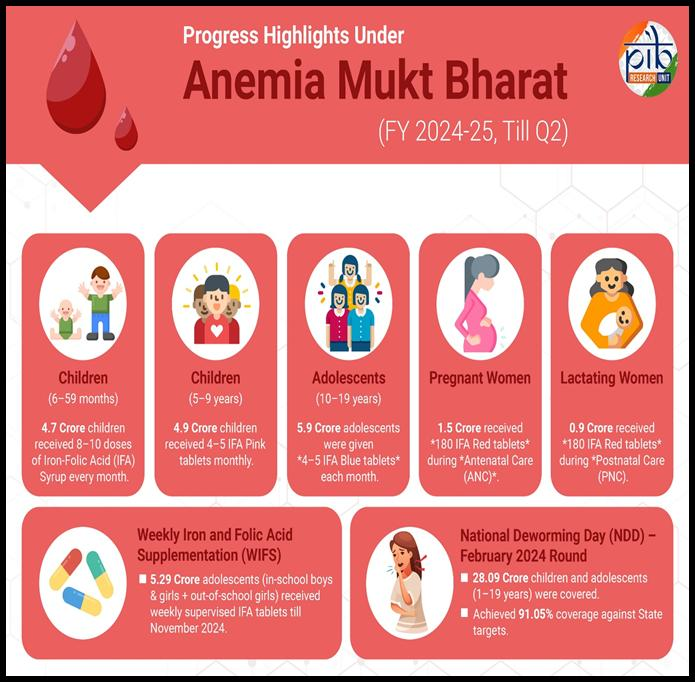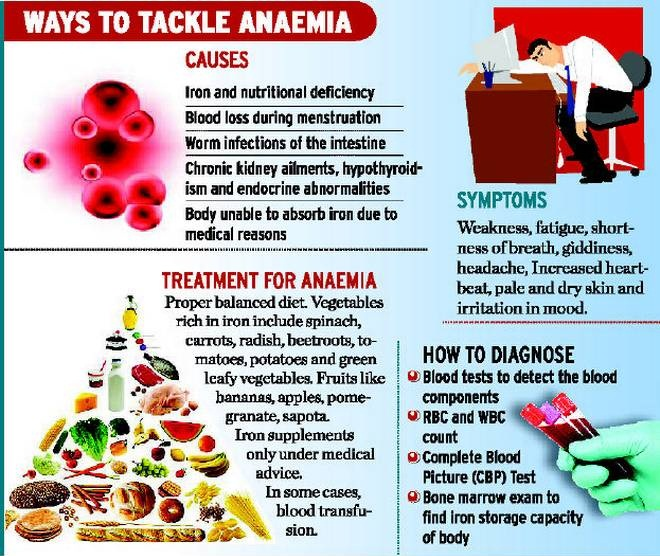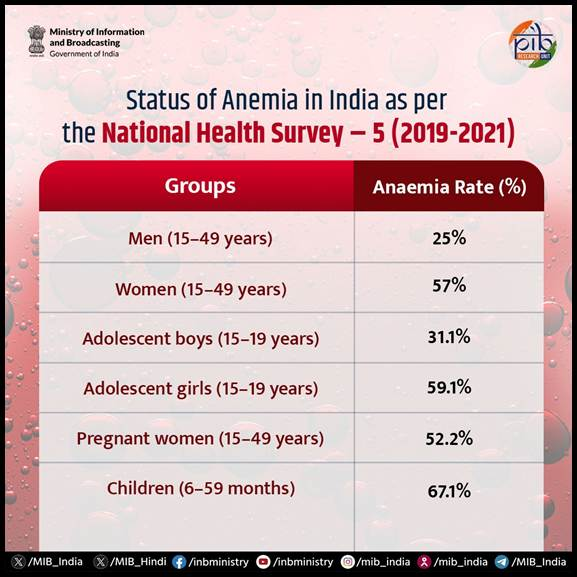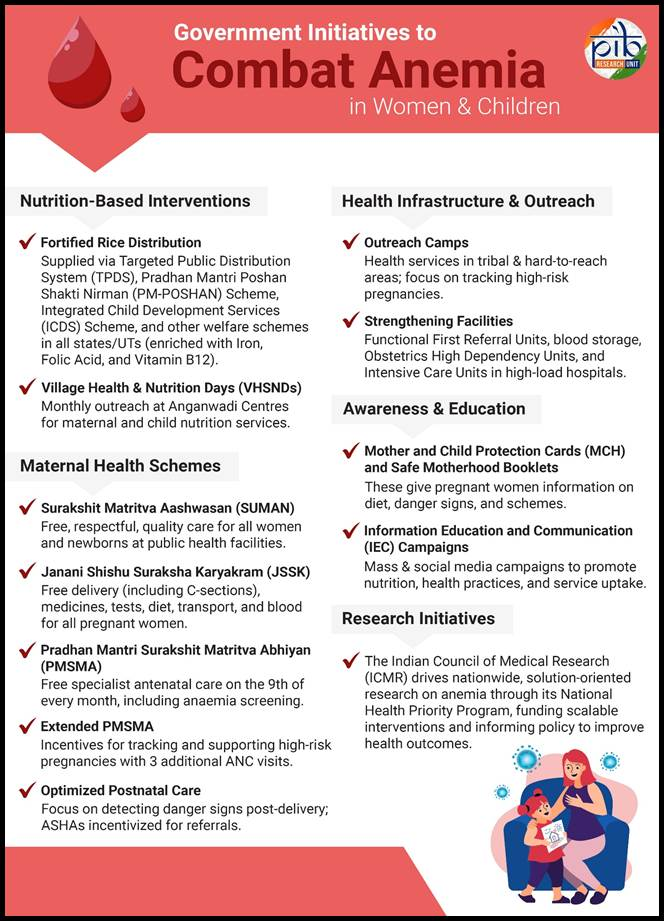India’s Fight Against Anemia | 22 Apr 2025
For Prelims: Anemia- Causes & Impact, Anaemia Mukt Bharat , 6X6X6 strategy, National Family Health Survey-5, Pradhan Mantri Surakshit Matritva Abhiyan.
For Mains: Women and Child welfare, Key Health initiatives.
Why in News?
The Ministry of Health and Family Welfare released a progress update on the Anemia Mukt Bharat (AMB) campaign, highlighting India’s sustained efforts to combat anemia, a major public health challenge.
What is Anemia Mukt Bharat (AMB) Campaign?
- About: It was launched in 2018 with the aim to reduce anemia through a 6x6x6 framework. It highlights major statistics from NFHS-5, including 67.1% of children and 59.1% of adolescent girls being anemic.
- The 6x6x6 framework targets 6 vulnerable groups with 6 key interventions through 6 institutional mechanisms to reduce anemia prevalence.
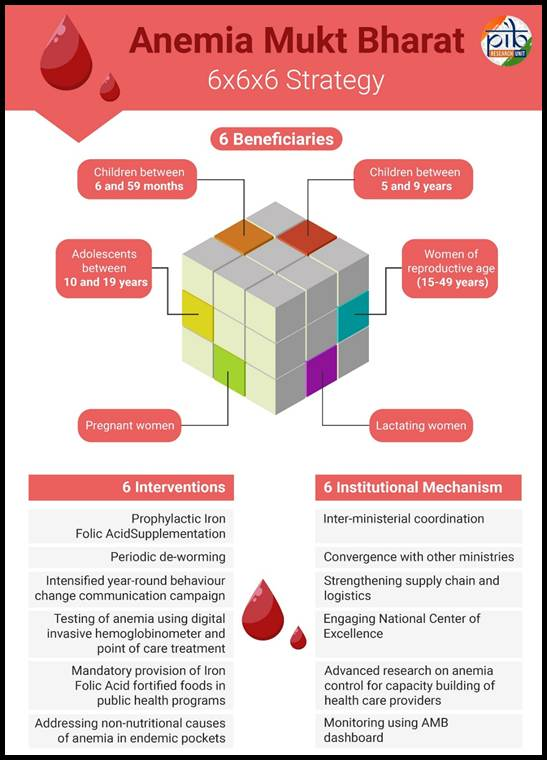
- 6 Key interventions:
- Iron and Folic Acid Supplementation: Age-appropriate Iron-Folic Acid (IFA) supplements are provided, with biweekly IFA syrup for children aged 6-59 months and weekly tablets for other groups.
- Deworming: Biannual deworming for children and adolescents (1-19 years) and antenatal deworming for pregnant women.
- Behavior Change Campaigns: Year-round campaigns focusing on key behaviors to combat anemia.
- Anemia Testing and Treatment: Use of digital methods for anemia screening, with special attention to pregnant women and adolescents.
- Fortification of Foods: Mandatory fortification of foods with Iron and Folic Acid in government programs.
- Awareness and Treatment for Non-Nutritional Causes: Special focus on malaria, hemoglobinopathies, and fluorosis in endemic areas.
- The 6x6x6 framework targets 6 vulnerable groups with 6 key interventions through 6 institutional mechanisms to reduce anemia prevalence.
- Progress Under AMB:
What is Anemia?
- About: Anemia is a condition primarily caused by iron deficiency, leading to low hemoglobin levels and reduced oxygen supply to organs, resulting in fatigue, weakness, and impaired physical and cognitive function.
- According to the WHO, women in the reproductive age group and having haemoglobin levels lower than 12 grams per decilitre (g / dL), as well as children under 5 with haemoglobin levels lower than 11.0 g / dL are considered anaemic.
- Vulnerability & Impact: Children under 5 (especially those under 2 years), adolescent girls, menstruating women, and pregnant and postpartum women are more vulnerable.
- Anemia causes Impair cognitive and motor development in infants and early children. In adults, it decreases work capacity. During pregnancy, it can lead to perinatal loss, prematurity, and low birth weight babies.
- Extent in India and Globally: Globally, 40% of children (6–59 months), 37% of pregnant women, and 30% of non-pregnant women (15–49 years) are affected by anemia.
- In 2019, anemia caused a loss of 50 million years of healthy life, primarily due to iron deficiency, thalassemia, sickle cell trait, and malaria.
- WHO Response: WHO has included anemia reduction as one of the 6 key targets in the Global Nutrition Targets and the UN 2030 Agenda for Sustainable Development.
- At the 2021 Nutrition for Growth Summit, WHO committed to developing a multisectoral framework for anemia prevention, diagnosis, and management, alongside UNICEF's Anaemia Action Alliance.
- WHO Global Nutrition Targets for 2025 (6 Key Goals):
- Reduce stunting in children under 5 by 40%
- Reduce anemia in women of reproductive age by 50%
- Reduce low birth weight by 30%
- Reduce childhood wasting to below 5%
- Increase exclusive breastfeeding in the first 6 months to 50%
- Prevent childhood obesity.
What are India’s Key Initiatives to Combat Anemia?
- Pradhan Mantri Surakshit Matritva Abhiyan (PMSMA)
- Health Management Information System (HMIS)
- Mission Utkarsh
- National Health Mission.
- Mother Child Tracking System (MCTS): This tracks and reports cases of anemia, especially among pregnant women.
- Blood Bank Operations: Strengthening blood banks in district hospitals to address severe anemia complications.
Conclusion:
India’s resolve to eliminate anemia reflects its broader commitment to inclusive and preventive public health. The Anemia Mukt Bharat strategy has made significant strides in reaching women, children, and adolescents through Iron-Folic Acid supplementation, deworming, etc. By focusing on the most vulnerable like girls, mothers, and young children, India is actively addressing the root causes of intergenerational malnutrition and promoting long-term human development.
|
Drishti Mains Question: Discuss the extent of the anemia burden in India and suggest effective strategies to address it, especially among vulnerable populations. |
UPSC Civil Services Examination, Previous Year Questions (PYQs)
Prelims
Q. Which one of the following statements best describes the role of B cells and T cells in the human body? (2022)
(a) They protect the body from environmental allergens.
(b) They alleviate the body’s pain and inflammation.
(c) They act as immunosuppressants in the body.
(d) They protect the body from the diseases caused by pathogens.
Ans: D
Q. Consider the following statements in the context of interventions being undertaken under Anaemia Mukt Bharat: (2023)
- It provides prophylactic calcium supplementation for pre-school children, adolescents and pregnant women.
- It runs a campaign for delayed cord clamping at the time of childbirth.
- It provides for periodic deworming to children and adolescents.
- It addresses non-nutritional causes of anaemia in endemic pockets with special focus on malaria, hemoglobinopathies and fluorosis.
How many of the statements given above are correct?
a) Only one
b) Only two
c) Only three
d) All four Interventions of Anaemia Mukt Bharat:
Ans: (c)
Mains
Q. Stem cell therapy is gaining popularity in India to treat a wide variety of medical conditions including Leukaemia, Thalassemia, damaged cornea and several burns. Describe briefly what stem cell therapy is and what advantages it has over other treatments? (2017)

